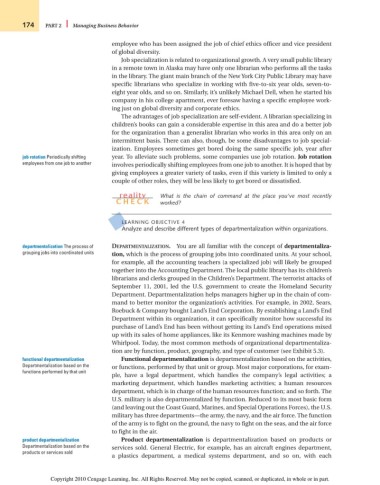Page 200 - Introduction to Business
P. 200
174 PART 2 Managing Business Behavior
employee who has been assigned the job of chief ethics officer and vice president
of global diversity.
Job specialization is related to organizational growth. A very small public library
in a remote town in Alaska may have only one librarian who performs all the tasks
in the library. The giant main branch of the New York City Public Library may have
specific librarians who specialize in working with five-to-six year olds, seven-to-
eight year olds, and so on. Similarly, it’s unlikely Michael Dell, when he started his
company in his college apartment, ever foresaw having a specific employee work-
ing just on global diversity and corporate ethics.
The advantages of job specialization are self-evident. A librarian specializing in
children’s books can gain a considerable expertise in this area and do a better job
for the organization than a generalist librarian who works in this area only on an
intermittent basis. There can also, though, be some disadvantages to job special-
ization. Employees sometimes get bored doing the same specific job, year after
job rotation Periodically shifting year. To alleviate such problems, some companies use job rotation. Job rotation
employees from one job to another involves periodically shifting employees from one job to another. It is hoped that by
giving employees a greater variety of tasks, even if this variety is limited to only a
couple of other roles, they will be less likely to get bored or dissatisfied.
reality What is the chain of command at the place you’ve most recently
CH ECK worked?
LEARNING OBJECTIVE 4
Analyze and describe different types of departmentalization within organizations.
departmentalization The process of DEPARTMENTALIZATION. You are all familiar with the concept of departmentaliza-
grouping jobs into coordinated units tion, which is the process of grouping jobs into coordinated units. At your school,
for example, all the accounting teachers (a specialized job) will likely be grouped
together into the Accounting Department. The local public library has its children’s
librarians and clerks grouped in the Children’s Department. The terrorist attacks of
September 11, 2001, led the U.S. government to create the Homeland Security
Department. Departmentalization helps managers higher up in the chain of com-
mand to better monitor the organization’s activities. For example, in 2002, Sears,
Roebuck & Company bought Land’s End Corporation. By establishing a Land’s End
Department within its organization, it can specifically monitor how successful its
purchase of Land’s End has been without getting its Land’s End operations mixed
up with its sales of home appliances, like its Kenmore washing machines made by
Whirlpool. Today, the most common methods of organizational departmentaliza-
tion are by function, product, geography, and type of customer (see Exhibit 5.3).
functional departmentalization Functional departmentalization is departmentalization based on the activities,
Departmentalization based on the or functions, performed by that unit or group. Most major corporations, for exam-
functions performed by that unit
ple, have a legal department, which handles the company’s legal activities; a
marketing department, which handles marketing activities; a human resources
department, which is in charge of the human resources function; and so forth. The
U.S. military is also departmentalized by function. Reduced to its most basic form
(and leaving out the Coast Guard, Marines, and Special Operations Forces), the U.S.
military has three departments—the army, the navy, and the air force. The function
of the army is to fight on the ground, the navy to fight on the seas, and the air force
to fight in the air.
product departmentalization Product departmentalization is departmentalization based on products or
Departmentalization based on the services sold. General Electric, for example, has an aircraft engines department,
products or services sold
a plastics department, a medical systems department, and so on, with each
Copyright 2010 Cengage Learning, Inc. All Rights Reserved. May not be copied, scanned, or duplicated, in whole or in part.

